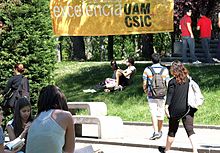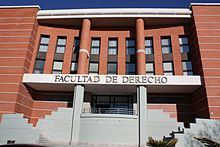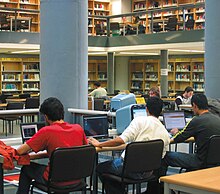Autonomous University of Madrid
The Autonomous University of Madrid (UAM) is a Spanish public university located in Madrid and founded in 1968.
UAM is one of the six public universities in the Community of Madrid together with the Complutense University of Madrid, the Carlos III University of Madrid, the Polytechnic University of Madrid, the University of Alcalá and the Rey Juan Carlos University.
Systematically located at the top of the rankings for its teaching and research excellence, the UAM is the Best University in Madrid and the second in Spain according to the QS Ranking 2022 and is among the 400 best universities in the world according to the Academic Ranking of World Universities (ARWU) or Shanghai Ranking 2021.
Like the Autonomous University of Barcelona and the University of Bilbao (later called the University of the Basque Country), the Autonomous University of Madrid was born thanks to Decree-Law 5/1968 approved by the Council of Ministers. This reform was carried out by the then Minister of Education and Science, José Luis Villar Palasí, to allow a university restructuring. Its official name as "Autonomous University of Madrid" appears in an Order of the Ministry of Education and Science of August 13, 1968.
The UAM was created to alleviate the problem of overcrowding in university classrooms. The first faculty to be built was that of Medicine, which was located next to the recently inaugurated Hospital La Paz. The Faculties of Philosophy and Letters, Economic and Business Sciences and Sciences are the oldest on the Cantoblanco campus, whose architectural design was devised, like the location of the campus, in imitation of Anglo-Saxon universities.
Campus
Its main campus is located in Cantoblanco, in the Fuencarral-El Pardo district of Madrid. It has &&&&&&&&02252000.&&&&&02,252,000 m² of total area. It was inaugurated on October 25, 1971, and is considered one of the 24 environmentally sustainable campuses in the world.
Accesses
- Cantoblanco Campus. Cantoblanco Campus is 15 kilometres from Madrid (i.e. 15 km from Puerta del Sol; taking as a reference neighborhoods in northern Madrid, such as Las Tablas, Montecarmelo or Sanchinarro, this campus is about 4 or 5 km away).
- Campus of Medicine. The Faculty of Medicine is located in the vicinity of the Hospital Universitario La Paz, in the northern part of Madrid.
Colleges and residences
- The UAM has its own management school, the Colegio Mayor Universitario Juan Luis Vives: It is located in Francisco Suárez street, in the district of Chamartín. It has 123 rooms for students of grade, postgraduate or teachers.
- ERASMO Residence: Private management is located on the campus of the University. It was opened in 2004 and expanded in 2008. It has 765 rooms for daily, weekly or year-round stays.
- Two major colleges:
- Colegio Mayor Santillana: Located on Marbella 60 Street, in the residential neighborhood of Mirasierra.
- Colegio Mayor Somosierra: Located on Calle Pablo Vidal, 6.
- And a mixed residence, subsidized by the Community of Madrid
- Residencia Ciudad Escolar-San Fernando. It has 200 rooms, both double and single. It is located in the Old Colmenar Road, km 12.8 in the School City educational enclosure, approximately 5 minutes from the University.
Colleges and schools
It has seven faculties and one school:
- Faculty of Sciences
- Faculty of Law
- Faculty of Philosophy and Letters
- Faculty of Psychology
- Faculty of Medicine
- Faculty of Economic and Business Sciences
- Faculty of Training and Education
- Higher Polytechnic School
Affiliated centers
It has four affiliated centers:
- Centro Superior de Estudios Universitarios La Salle
- Red Cross Nursing
- Sinería de la Fundación Jiménez Díaz
- ONCE Physiotherapy
Other centers
- Centro de Biología Molecular Severo Ochoa (CBMSO)
- Centre for Documentation and Studies for the History of Madrid
- East Asian Studies Centre;
- Scientific Computing Centre
- Micro-Analysis Materials Center
- Applied Psychology Center
- Centre of Political Theory
- Centro Internacional Carlos V
- Higher Centre for Asiriology and Egyptian Studies
- Centro Superior de Investigación y Promoción de la Música
- Clinical Pharmacology Center
- School of Gemology
- UAM Economic Intelligence School (La_SEI)
- UAM/El País School of Journalism
- Fundación interuniversitaria Fernando González Bernáldez
- Institute of Forensic and Security Sciences (ICFS)
- Institute of Mathematical Sciences
- Institute of Theoretical Physics
- Institute of Knowledge Engineering;
- Instituto de Investigaciones Biomédicas Alberto Sols
- La Corte University Institute in Europe (IULCE)
- Cartographic Service
- General Experimental Research Support Services (SEGAINVEX);
- Microelectronic Workshop]
- Workshop on International Mediterranean Studies
Library and Archive
Eight faculty libraries and various documentation centers serve the entire university community, providing the information resources necessary for the development of research, teaching and study:
- Science Library
- Law Library
- Economics Library
- Library of Education
- Library of Humanities
- Library of Medicine
- Library of Psychology
- Polytechnic Library
To these service points are added other specialized centers: Archive, Rafael Más Map Library, Natural Areas Documentation Center, Statistical Documentation Center and European Documentation Center.
In addition, the Library and Archive belongs to the Madroño Consortium of University Libraries of Madrid, which allows all its users to access the information resources that are acquired in partnership with these libraries, as well as the services that are articulated in cooperative way. It is also a member of REBIUN (Network of Spanish University Libraries) and other professional associations: IFLA (International Federation of Library Associations and Institutions), Liber (Ligue des Bibliothèques Européennes de Recherche) and Sedic.
Museums
The Autonomous University has three museums:
- Museum of Popular Arts and Traditions and the Cabinet of Arab and Islamic Anthropology and Folk, coordinated by La Corrala Cultural Centre
- Museum of Mining
- Museo de la Escuela Politécnica Superior
Motto
The motto of the University is the Latin phrase Quid Ultra Faciam? (What else shall we do?). This motto has been used to title the book that collects works from the 25 years of existence of the University and is called Quid ultra faciam? Works in Greek, Latin and Indo-European in commemoration of the 25th anniversary of the Autonomous University of Madrid.
Symbols
The University has four symbols: the shield, the flag, the logo and the seal. The shield, according to article 5 of the UAM statutes, must be a «split shield, crowned with a gold crown, with nine fleurs-de-lys. In the right barracks, on a field of gules, a gold flamingo with three silver flames will reign; In the left quarter, on a silver field, a rampant bear will roam on a strawberry tree. It will be surrounded by a laurel and in the lower part of it will have a phylactery with the motto Quid ultra faciam?". The flag and seal are made from this shield. The flag will be green with the shield in the center, while the seal will reproduce the shield.
Academic ranking of universities
Consideration according to the academic rankings of universities:
- Academic Ranking of World Universities [ARWU] (2016): Between 201 and 300 in the world ranking of universities; the second of the Spanish in the ranking. By study areas (2016): Between 101-150 in Natural and Mathematical Sciences. By study disciplines (2015/16): Between position 51-75 in Mathematics; and in Physics; 301-400 in Environmental Science and Engineering; and in Materials Science and Engineering
- QS World University Rankings (2016): Position 210 in the world rankings of universities; Position 3 among Spanish universities; Position 11 among the 50 best universities younger than 50 years old. By study areas (2015): Position 149 in Arts and Humanities; 234 in Engineering and Technology; 228 in Life and Medicine Sciences; 103 in Natural Sciences; 183 in Social Sciences and Administration. By study disciplines (2016):
- between position 51-100 in Archaeology; in Physics and Astronomy; and in Law.
- between position 101-150 in History; in Modern Languages; in Agriculture and Forest Sciences; in Pharmacy and Pharmacology; in Psychology; in Mathematics; in Chemistry; in Materials Sciences; and in Geography and Regional Studies.
- between the position 151-200 in Linguistics; in Philosophy; in Medicine; in Environmental Studies; in Finance and Accounting; in Sociology; in Education; and in Economics and Econometry.
- between 201-250 in English Language and Literature; and in Biological Sciences.
- between 251-300 in Electrical and Electronic Engineering;
- The Higher Education World University Rankings (2016): Between 351 and 400 in the world rankings of universities; position 71 among the 150 best universities with less than 50 years.
Student mobility
The Office of the Vice President for International Relations is in charge of promoting the academic mobility of students through mobility programs such as Erasmus, international agreements, Banco Santander scholarships, Sicue and the Swiss mobility program. It has agreements with around 600 educational institutions around the world, to carry out undergraduate, postgraduate and language learning academic exchanges. High-level institutions such as the University of Cambridge, University College London, Imperial College London, the University of Manchester, the University of Edinburgh, the University of Warwick in the United Kingdom, the National University of Singapore in Singapore, the University of Toronto of Canada, the University of New York and the University of Colorado at Boulder in the United States, the Pierre and Marie Curie University, the University of Paris-South and the École polytechnique of France, the University of Melbourne and the University of Sydney of Australia, Germany's Heidelberg University, South Korea's Seoul National University and China's Peking University are among its agreements. The countries with institutions to carry out these international exchanges are the following:
Rectors
- Luis Sánchez Agesta (1970-1972)
- Julio Rodríguez Martínez (1972-1973)
- Gratiniano Nieto Gallo (1973-1978)
- Pedro Martínez Montávez (1978-1982)
- Julio González Campos (1982-1984)
- Josefina Gómez Mendoza (1984-1985)
- Cayetano López Martínez (1985-1994)
- Raúl Villar Lázaro (1994-2002)
- Angel Gabilondo Pujol (2002-2009)
- José María Sanz Martínez (2009-2017)
- Rafael Garesse Alarcon (2017-2021)
- Amaya Mendikoetxea Pelayo (2021-current)
Students
Faculty
Contenido relacionado
Trachtenberg method
Oxford English Dictionary
Brno




